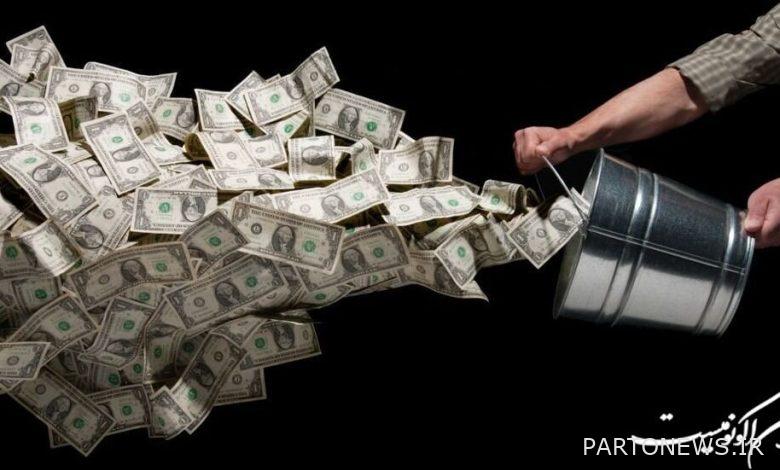Reducing the share of the dollar in the foreign exchange reserves of the world’s central banks

According to Iran Economist, in an analysis of the position of the dollar among the world’s foreign exchange reserves, the International Monetary Fund wrote: The US dollar has played a significant role in the world markets for a long time. Although the share of the American economy in the world production has been decreasing over the past two decades, the role and position of the dollar in the world markets has continued to be leading.
It should be said that the role and presence of the US dollar in trade, international debts and non-bank debt is in no way proportional to this country’s share of trade, bonds and international debts. At the same time, the central banks of the world keep less dollars in their foreign exchange reserves than before.
International Monetary Fund statistics show that in the fourth quarter of 2021, the share of the dollar in the world’s foreign exchange reserves has reached less than 59%. During the last two decades, this trend has been decreasing.
As a good example of the reduction of the dollar’s share in the world’s foreign exchange reserves, we can mention Israel (the Zionist regime), which has close relations with the United States. The central bank of this regime has developed a new strategy for its foreign exchange reserves of 200 billion dollars, according to which, from the beginning of 2022, the share of the US dollar in these reserves will be reduced and a greater share will be given to the Australian dollar, Canadian dollar, Chinese yuan and Japanese yen. Is.
As stated in one of the recent reports of the International Monetary Fund, the decrease in the role of the US dollar in the world’s foreign exchange reserves has not been accompanied by an increase in the role of other traditional reserve currencies such as the euro, yen and pound. In addition, although the share of the Chinese yuan in foreign exchange reserves has increased to some extent, this figure is only equivalent to a quarter of the total lost share of the US dollar in recent years. Also, the data of the International Monetary Fund show that at the end of 2021, only one country, Russia, has almost a third of the world’s foreign exchange reserves of yuan.
On the other hand, the national currencies of smaller economies that have not traditionally had an important place in foreign exchange reserves, such as the Australian and Canadian dollars, the Swiss krone and the South Korean won, have taken three-fourths of the lost share of the US dollar in the world’s foreign exchange reserves.
Why did this happen? Why have we witnessed the entry of new currencies into the composition of the world’s foreign exchange reserves? Two factors can be mentioned in this regard. The first reason is that these currencies have had higher returns and less volatility. Such characteristics are very attractive and seductive for central banks.
New financial technologies, such as automated cash management systems, have made it easier and cheaper to trade in the national currencies of smaller economies.
Some of these economies have swap agreements with the US Federal Reserve, which conveys the message that their national currencies maintain their value against the US dollar.
Of course, the importance of this factor can be questioned. Contrary to popular belief, the new currencies that have been added to the composition of the world’s foreign exchange reserves are highly volatile. These currencies go up and down a lot against the US dollar. Issuers of these currencies have rarely resorted to swap agreements with the Federal Reserve to maintain their value.
A more plausible reason is that these new and non-traditional currencies are issued by countries that have open capital accounts and have stable and strong policies. What forces central banks to introduce a new currency in the composition of their foreign exchange reserves is not only the economic weight and financial depth of the country that owns that currency, but also the transparency and predictability of that country’s policies also play an important role in this field. In other words, stability in the economy and political decisions are very important for a currency to be accepted at the international level.
Holders of foreign exchange reserves tend toward currencies whose governments are known for good governance, economic stability, and sound financial health.
* The world’s foreign exchange reserves lost 92 billion dollars
According to this report, the International Monetary Fund has announced that the total foreign exchange reserves of the world at the end of 2021 will be 12,920 billion dollars. The world’s foreign exchange reserves at the end of 2021 have decreased by 92 billion dollars compared to the previous three months. At the end of the third quarter of 2021, the total foreign exchange reserves of the world were announced as 12,828 billion dollars.
According to this report, the share of the US dollar in the total foreign exchange reserves of the world at the end of 2021 amounted to 58.8%. Euro with a share of 20.5% and Japanese yen with a share of 5.5% were the second and third currencies in the world’s foreign exchange reserves, respectively. The share of the Chinese yuan in the world’s foreign exchange reserves was 2.8%, the British pound was 4.8%, the Australian dollar was 1.8%, and the Canadian dollar was 2.3%.

